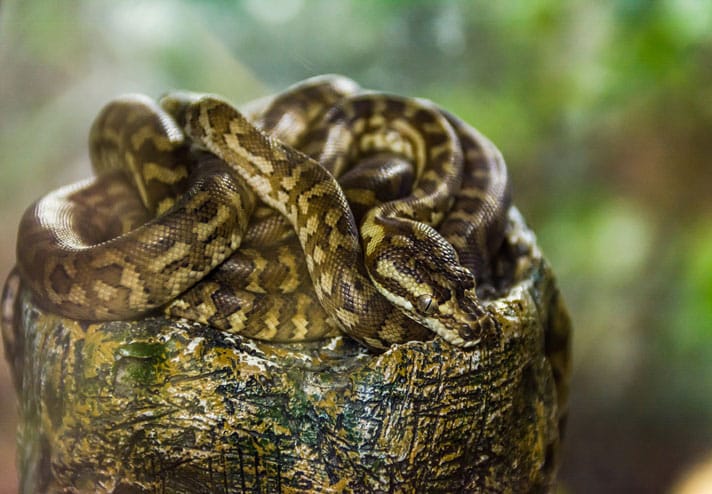Description:
The anthill python is a smallish snake that does well in a standard python set up. A terrarium measuring 36 inches long by 12 inches tall and 12 inches deep will easily house one or two adults. A substrate of a few inches of aspen bedding works well. A couple of hides — one at each end of the enclosure — will make your anthill python feel secure and comfy. Use an undertank heating pad to create a hot spot of about 100 degrees Fahrenheit at one end of the enclosure. Otherwise, the ambient temperature of the rest of the enclosure should be kept at about 80 degrees. At the cooler end opposite the one with the heating pad, place a water bowl that is large enough for the snake to stick its head in to drink. You can add artificial plants, logs, cork bark and other decor to suite your taste and give your anthill python something interesting to crawl on and under. Make sure the terrarium has a secure top, as like most snakes, anthill pythons will escape if given the chance. A fluorescent light can be used to illuminate the python enclosure during the daytime; a 12-hours-on, 12-hours-off light cycle works best. In the wild, anthill pythons feed on lizards and small mammals. In captivity, they do very well on a diet of frozen/thawed hopper mice or small adult mice. What’s available: All anthill pythons sold in the U.S. are captive bred because, as with all Australian wildlife, wild specimens are illegal to export out of that country. The breeding and availability of anthill pythons seems to come in waves; either there are a lot out there for sale or none at all. If you decide to get one, you may have to wait and catch the wave when it’s on its way up before you’re able to find any. Antaresia perthensis are rarely seen in stores, but specialty reptile stores often stock them when they can find them. Otherwise, you might have luck finding specimens for sale online or at reptile shows. The anthill python is named for the fact that wild specimens spend a lot of time in and around termite mounds in Australia. These mounds attract a wide variety of wildlife, including the lizards and small mammals upon which wild anthill pythons feed. In addition, anthill pythons will also inhabit termite mounds. A mostly uniform temperature is maintained inside them, resulting in a perfect spot for the snakes to thermoregulate. Easy to keep, the anthill python does well in captivity and rarely, if ever, bites (and because it’s small, a bite is not of much concern anyway). Its size makes this a great pet for hobbyists with limited space.
Habitat:
Hilly and rocky areas, semi-arid areas covered in grasses, as well as in and around anthills
Range:
Western Australia
Scientific Name: Antaresia perthensis
Species Group: python
Family: Pythonidae
Size:
Level: intermediate
Weight:
Dangerous: No



